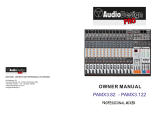
Allen & Heath 11 ZED-4 BUS User Guide
INTRODUCTION TO THE ZED-4 BUS MIXERS
A Technical Overview:
The Allen & Heath ZED-4 mixer has been carefully and lovingly designed in the beautiful county of Cornwall in the UK and is
manufactured alongside a wide range of professional audio mixing consoles. Many of the components used in ZED are exactly
the same as in the larger Allen & Heath products and the construction methods are also very similar — utilising individual ver-
tically mounted channel circuit boards with each rotary control fixed with a metal nut to the front panel. This provides a very
robust product that will resist damage and give years of reliable use. It also makes servicing much easier should it be required,
with the ability to remove one particular channel from the mixer at a time, or easily change a fader.
The audio circuitry is based on years of continual development and refinement, the performance of all the elements within the
mixer scrutinised and perfected to ensure the very best sound quality possible.
Mic/Line Pre-amps:
Based on the pre-amps from the PA series, the ZED series pre-amps use a two stage design, with carefully controlled amounts
of gain in each stage. When amplifying the signal from the XLR input, the gain range is huge — 69dB of range to be exact —
and is very evenly distributed around the gain control, meaning better control of signal level. Most of the gain comes from the
first stage, so unwanted noise is kept to a minimum. There is no “pad” switch, or pad circuit — line level signals are simply
plugged into the second stage of the pre-amp by using the line input jack socket. This has the great advantage of lower noise
when using the line input. (It is common to attenuate line level signals, the amplify them back up again which can give more
noise or hiss).
EQ:
The ZED-4 series mixers are equipped with a 4-band equaliser circuit on each input, based closely on the acclaimed GL2400
EQ. The frequency and response of each has been carefully chosen to give the maximum performance when using the EQ on a
variety of sources.
AUX system:
Six auxiliary sends are provided, two pre-fade, two post fade, and two switched pre or post fade. The Aux master level con-
trols are grouped nicely together in the master section and have AFL (after fade listen) switches for monitoring.
Groups:
The four sub-groups can be used for easy control of groups of inputs, or for applying signal processing such as compression to
groups of signals using the Group Insert connector. The groups have individual outputs and can also be sub-mixed to the main
L-R and Mono mixes.
Main Mix:
In addition to the main L-R stereo bus, there is a Mono bus which can be routed to individually, ideal for feeding low frequency
speaker systems, or creating a mono PA mix.
Mono and Stereo Channels:
The ZED-420, 428 and 436 models have a full complement of 16, 24 and 32 mono inputs respectively, plus two stereo chan-
nels, maximising the number of inputs you get. The Stereo channels are dual, so you can get 4 stereo inputs to mix before you
need to use any mono channels.
USB:
Getting audio to and from a computer easily is now a common requirement for live sound and music production. The way we
have implemented this on ZED is super-flexible and super-easy! No longer do you need to fiddle around the back of your PC
to get to the soundcard inputs, only to find that the levels are all wrong and noisy. Just plug in a USB lead to your ZED, select
the USB routing on the mixer and the device on your computer and that’s it! Quality audio to and from your PC or MAC.
As you can tell, we’re very proud of this product we hope you like it too!




















